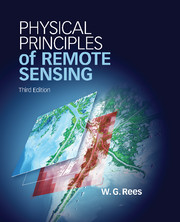Book contents
- Frontmatter
- Contents
- Preface
- Acknowledgements
- 1 Introduction
- 2 Electromagnetic waves in free space
- 3 Interaction of electromagnetic radiation with matter
- 4 Interaction of electromagnetic radiation with the Earth's atmosphere
- 5 Photographic systems
- 6 Electro-optical systems
- 7 Passive microwave systems
- 8 Ranging systems
- 9 Scattering systems
- 10 Platforms for remote sensing
- 11 Data processing
- Appendix Data tables
- References
- Index
- Plate Section
9 - Scattering systems
Published online by Cambridge University Press: 05 December 2012
- Frontmatter
- Contents
- Preface
- Acknowledgements
- 1 Introduction
- 2 Electromagnetic waves in free space
- 3 Interaction of electromagnetic radiation with matter
- 4 Interaction of electromagnetic radiation with the Earth's atmosphere
- 5 Photographic systems
- 6 Electro-optical systems
- 7 Passive microwave systems
- 8 Ranging systems
- 9 Scattering systems
- 10 Platforms for remote sensing
- 11 Data processing
- Appendix Data tables
- References
- Index
- Plate Section
Summary
In this chapter we complete our survey of the principal types of remote sensing instrument by discussing those active systems that make direct use of the backscattered power. Optical (LiDAR) systems are used for sounding clouds, aerosols and other atmospheric constituents, for characterising surface albedo, and for measuring wind speeds. These are discussed briefly in Section 9.1. However, the bulk of this chapter is concerned with microwave (radar) systems. (‘Radar’ is an acronym, originally standing for ‘radio detection and ranging’. The functions that can be performed by microwave scattering systems now extend far beyond detection and ranging, but the term continues to be in very general use.)
In Section 9.2 the ground-work established in Chapter 3 is extended to a derivation of the radar equation, which shows how the power detected by a radar system is related to the usual measure of backscattering ability, the differential backscattering cross-section σ0. The remainder of the chapter discusses the main types of system that employ this relationship. The first and simplest is the microwave scatterometer (Section 9.3), which measures σ0, usually only for a single region of the surface but often for a range of incidence angles. As described here, this is not an imaging system, although the distinction between microwave scatterometers and imaging radars is not a precise one.
- Type
- Chapter
- Information
- Physical Principles of Remote Sensing , pp. 281 - 317Publisher: Cambridge University PressPrint publication year: 2012



